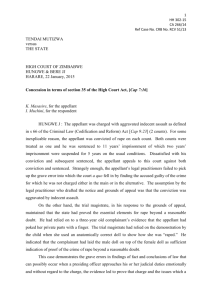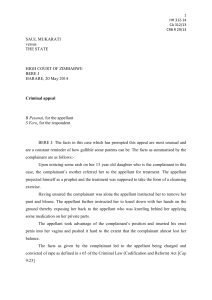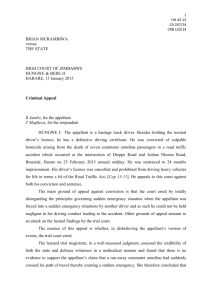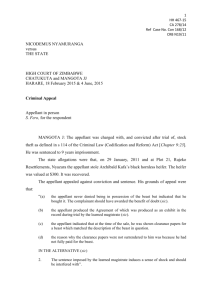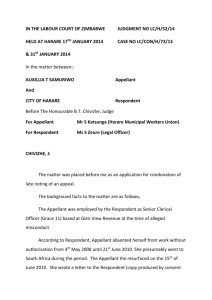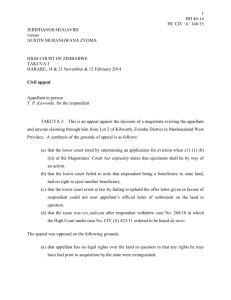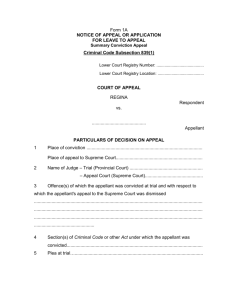HH 185-15
advertisement
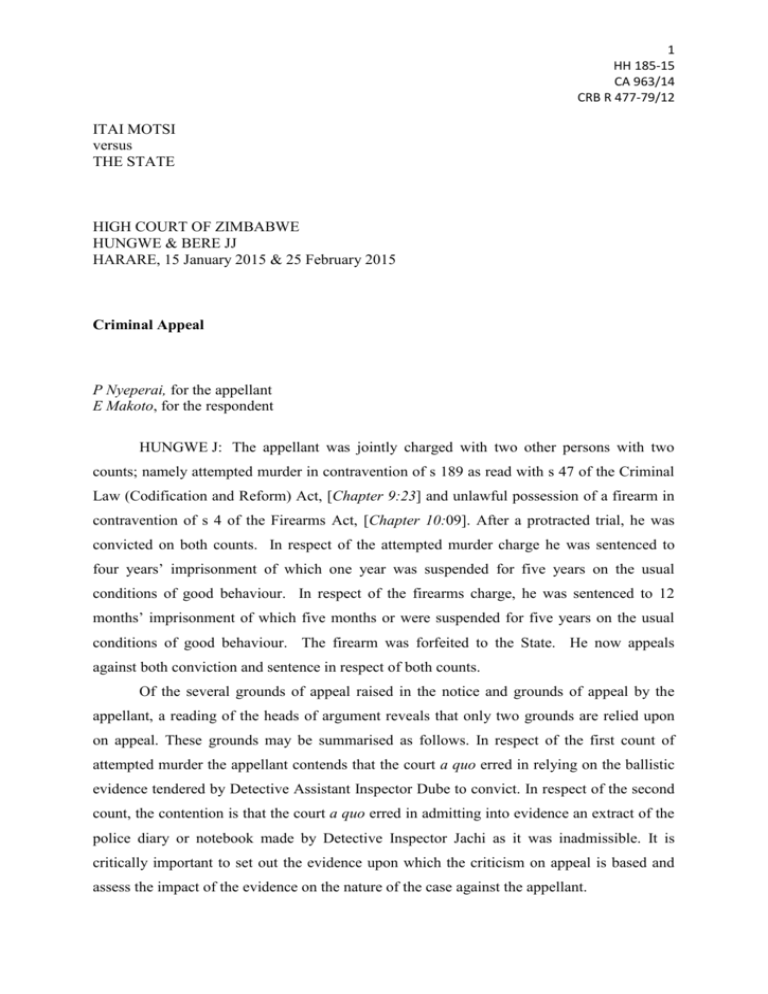
1 HH 185-15 CA 963/14 CRB R 477-79/12 ITAI MOTSI versus THE STATE HIGH COURT OF ZIMBABWE HUNGWE & BERE JJ HARARE, 15 January 2015 & 25 February 2015 Criminal Appeal P Nyeperai, for the appellant E Makoto, for the respondent HUNGWE J: The appellant was jointly charged with two other persons with two counts; namely attempted murder in contravention of s 189 as read with s 47 of the Criminal Law (Codification and Reform) Act, [Chapter 9:23] and unlawful possession of a firearm in contravention of s 4 of the Firearms Act, [Chapter 10:09]. After a protracted trial, he was convicted on both counts. In respect of the attempted murder charge he was sentenced to four years’ imprisonment of which one year was suspended for five years on the usual conditions of good behaviour. In respect of the firearms charge, he was sentenced to 12 months’ imprisonment of which five months or were suspended for five years on the usual conditions of good behaviour. The firearm was forfeited to the State. He now appeals against both conviction and sentence in respect of both counts. Of the several grounds of appeal raised in the notice and grounds of appeal by the appellant, a reading of the heads of argument reveals that only two grounds are relied upon on appeal. These grounds may be summarised as follows. In respect of the first count of attempted murder the appellant contends that the court a quo erred in relying on the ballistic evidence tendered by Detective Assistant Inspector Dube to convict. In respect of the second count, the contention is that the court a quo erred in admitting into evidence an extract of the police diary or notebook made by Detective Inspector Jachi as it was inadmissible. It is critically important to set out the evidence upon which the criticism on appeal is based and assess the impact of the evidence on the nature of the case against the appellant. 2 HH 185-15 CA 963/14 CRB R 477-79/12 The court a quo heard evidence from seven witnesses called by the state. Only the complainant in the attempted murder charge was a non-police witness. The rest were. I will discuss the evidence of Detective Assistant Inspector Dube and its probative value vis-a-viz the appellant’s conviction on the first count of attempted murder. The appellant was convicted for attempted murder on the basis that the expert evidence from the ballistic examination identified the weapon recovered from the appellant’s residence as the one that was fired at the complainant in the attempted murder charge. In respect of this count the following facts were largely not in dispute. On 29 February 2012 the complainant was trailed by two motor vehicles as he drove home from town. The one vehicle gave up the pursuit before complainant went out of town. The other pursued him out of town. When he got to a certain spot, the complainant decided to pull off the road and see whether his pursuers would drive past. They did not. They pulled up alongside his vehicle and opened the off-side doors. Complainant saw the barrel of a gun and decided to speed off. He was shot at, with one bullet head lodging in the boot of his motor vehicle. He later discovered another lodged in a loaf of bread. After the assailants drove back into town, the complainant drove to the nearest police station. He took two police officers to the scene of the shooting that same night. The police officers recovered three spent cartridges from the tarred road at the scene of the shooting and one bullet head from the complainant’s motor vehicle boot. These were taken to Marlborough Police Station. The investigating officer, Detective Inspector Brian Maigeta conveyed these items to Assistant Inspector Innocent Dube (“Dube”) of the Police Ballistics Laboratory for examination and further processing on 6 March 2012.Dube produced a report on 12 March 2012 in which he stated the following: “REPORT On the 6th of March 2012 the following were received per hand of number 056826 R Detective Sergeant Maigeta: (a) 3 x 9 x19mm Fired cartridge cases (b) 1 x bullet head Examination of exhibit (a) showed that they are 9 x19mm fired cartridge cases which were discharged from the same weapon that chambers 9 x19mm live ammunition. Examination of exhibit (b) showed that it is a 9mm bullet head which was discharged from a weapon the chambers 9mm live ammunition. Exhibits (a) and (b) did not match any outstanding scenes in the laboratory.” 3 HH 185-15 CA 963/14 CRB R 477-79/12 On 23 May 2012 Dube produced another report in the same format to the following effect. He had received from Detective Sergeant Nhokwara (“Nhokwara”) a 9mm CZ pistol serial number 20799/ BSAP 423 and a .38 Special Taurus revolver without a serial number as it had been erased. The two firearms were functional. He wrote; “Examination of the chambers and barrels of exhibits (a) and (b) showed some deposits of gunshot residue an indication that weapons (a) and (b) were fired but cannot ascertain when they were fire. Test cases from exhibit (a) matched exhibits (a) and (b) in FB65/2012, (CID HOMICIDE HARARE, MARLBOROUGH CR 12/3/2012, ATTEMPTED MURDER, CORNER ALENDALE ROAD AND KATHLEEEN CHRISTON BANK ON 29/02/2012). Test cases fired from exhibit (b) did not match any outstanding scenes in the laboratory. Weapons (a) and (b) were manufactured after 1900.” On 18 May 2012 a team of detectives led by Detective Inspector Alexander Jachi of the Criminal Investigating Department’s Vehicle Theft Squad, investigating some other offences received a report concerning the appellant and others. That report gave them reasonable cause to believe that they might be able to recover firearms from the appellant. Acting on this piece of information the team proceeded to Dema. They found the appellant at his uncle’s homestead and placed him under arrest. They asked him to take him to his residence which was a single flat-roofed room some 200m away. In the presence of his uncle, a search of the appellant’s room yielded a CZ pistol from between the mattress and base-bed. There is dispute as to whether the appellant and his uncle voluntarily signed an acknowledgement of the recovery of the fire-arm. This is the pistol handed to Dube on 21 May 2012 by Nhokwara. This information was relayed to Detective Sergeant Maigeta (“Maigeta”) who is the investigating officer for the Christon Bank attempted murder report. Appellant and his co-accused were then charged for attempted murder and unlawful possession of fire-arms. The defence attacked the ballistics reports as so lacking in detail that it could not possibly be the basis for the conclusions made by Dube. In court Dube suggested that the weapon recovered at appellant’s Dema residence was the same weapon which was fired during the commission of the attempted murder charge. Despite the heavy criticism of the lack of detail in the report by the defence, the learned trial magistrate went on to accept the report by Dube as sufficient evidence to link the appellant to the attempted murder of the complainant. The trial magistrate also pointed to the fact that the appellant was known to his erstwhile co-accused as another factor which strengthened the case against the appellant 4 HH 185-15 CA 963/14 CRB R 477-79/12 since, according to the court a quo, that other co-accused was linked to the break-in in Bulawayo in which the pistol was stolen. He accepted that there was no eye witness to the shooting which placed the appellant at the scene but still held it proper to convict the appellant. He reasoned that because the pistol found inside appellant’s residence was found to have been fired, therefore it was the appellant who fired it. He convicted the appellant of illegal possession of the fire-arm too. Mr Nyeperai, for the appellant, persisted with his argument that there was no sufficient evidence that the CZ pistol was the same pistol fired in the attempted murder incident at Christon Bank. It was incumbent on the expert witness to have recorded the similarities which he testified to in court as the basis of the opinion which he expressed in court that the pistol recovered from the appellant is the same one fired on the complainant. Because he did not, the opinion he expressed ought not to have been accepted by the court below. The Constitutional Court of South Africa expressed itself on the subject of expert witnesses in Glenister v President of the Republic of South Africa and Others (CCT 28/13) (2013) ZACC 20; 2013 (11) BLCR 1246 (CC) (14 June 2013) (accessed on 9 February 2015) “In essence, the function of an expert is to assist the court to reach a conclusion on a matter on which the court itself does not have the necessary knowledge to decide. It is not the mere opinion of the witness which is decisive but his ability to satisfy the court that, because of his special skill, training or experience, the reasons for the opinions he expresses are acceptable. Any expert opinion which is expressed on an issue which the court can decide without receiving expert opinion is in principle inadmissible because of its irrelevance. The rule was crisply stated in Gentiruco A.G. v Firestone S.A. (Pty.) Ltd.1972 (1) SA 589 (A) at 616H: ‘[T]he true and practical test of the admissibility of the opinion of a skilled witness is whether or not the Court can receive “appreciable help” from that witness on the particular issue’. Expert witness testimony on an ultimate issue will more readily tend to be relevant when the subject is one upon which the court is usually quite incapable of forming an unassisted conclusion. On the other hand the opinion of the witness is excluded not because of a need to preserve or protect the fact-finding duty of the court, but because the evidence makes no probative contribution.” Expert testimony, like all other evidence, must be given only appropriate weight. It must be as influential in the overall decision-making process as it deserves: no more, no less. The weight to be given to expert evidence will derive from how that evidence is assessed in the context of all other evidence. This is because, while expert evidence is important evidence, it is nevertheless merely part of the evidence which a court has to take into account. Two critical matters spring to mind as a consequence. Firstly, expert evidence does not “trump all other evidence”. Woodhouse v Britannic Assurance p.l.c., Employment Appeal Tribunal, U.K.E.A.T. 0132/03/RN para. 25. 5 HH 185-15 CA 963/14 CRB R 477-79/12 Expert evidence should be tested against known facts, as it is the primary factual evidence which is of the greatest importance. It is therefore necessary to ensure that expert evidence is not elevated into a fixed framework or formula, against which actions are then to be rigidly judged with a mathematical precision. Stewart v Glaze (2009) E.W.H.C. 704. In HKSAR v Chan Sze Pui, Gloria (2004) H.K.C.U. 298it was held that a court is not compelled to accept the evidence of an expert but is entitled to accept or reject that evidence like any other, bearing in mind the whole of the evidence in the case. The court had placed the expert testimony in the context of the whole of the evidence and determined what weight could be placed upon it. Secondly, a court must not consider expert evidence in a vacuum. It should not therefore be artificially separated from the rest of the evidence. To do so is a structural failing. A court’s findings will often derive from an interaction of its views on the factual and the expert evidence taken together. The more persuasive elements of the factual evidence will assist the court in forming its views on the expert testimony and vice versa. Similarly, the South African courts have said that expert testimony can serve as a useful tool or guide against which the reliability of the testimony of eyewitnesses can be checked and tested. Van der Westhuizen and Another v SA Liberal Insurance Co. Ltd 1949 (3) S.A. 160 (C). It is for the court to determine, on the balance of probability, on all the evidence, where the probabilities lie. In Routestone Ltd v Minories Finance Ltd and Another (1997) B.C.C. 180. JACOB J observed that what really mattered in most cases was the reasons given for an expert’s opinion, noting that a well-constructed expert report containing opinion evidence sets out both the opinion and the reasons for it. The judge pithily commented “(if) the reasons stand up the opinion does, if not, not” (at p 188). A court should not therefore allow an expert merely to present their conclusion without also presenting the analytical process by which they reached that conclusion. In R v Nyamayaro 1967 (4) SA 263 (RA) BEADLE CJ adopted the well-known dicta of GREENBERG JA in Annama v Chetty and Others 1947 AD 142 @ p 155 where the learned Judge of Appeal said, in speaking of the evidence of a handwriting expert: “His function is to point out similarities or differences in two or more specimens of handwriting and the court is not entitled to accept his opinion that these similarities or differences exist, but once it has seen for itself the factors to which the expert draws attention, it may accept his opinion in regard to the significance of these factors.” (See also S v Sibanda 1963 (4) SA 182 (SR)) 6 HH 185-15 CA 963/14 CRB R 477-79/12 The fact of the matter in the present case is that the expert witness Dube did not compile his report in a manner which would permit a court to understand and follow the reasoning behind his conclusions. He sought to excuse the scanty nature of his report by stating that although it was desirable to include the detail which would allow the court to follow his reasoning, this was not a legal requirement for the sufficiency of his report. In maintaining this stance, he failed to play his role as an expert. Dube ought to have demonstrated those grooves, if such were present, their similarities in their location on both sets and so on, in order to enable the trial court to make its own conclusion as to the probative value of his expressed opinion regarding the issue to be decided. It is clear his testimony, in its present form could not possibly have helped the court to decide the question it was faced with. I am persuaded by the argument so clearly laid down in the case law, in this and other jurisdictions, that there has to be such evidence laid before the trier of fact as sufficient for him or her to make up his own mind as to the correctness of any proposition which the expert makes in his testimony. Clearly there is nothing, besides Dube’s say so, to enable the court a quo to have arrived at the conclusion that the bullet which was fired at the complainant in the Christon Bank incident was discharged by the pistol recovered from the appellant. As such one cannot state with certainty that this was indeed the case, as the prosecution argued. Without this detail, the trial court was not entitled to find, as it did, that the expert’s evidence was admissible. It was not. His opinion was not backed by evidence. It remained that; an opinion; and was therefore irrelevant to the issue to be decided. Without the ballistic expert’s evidence, there is no evidence linking the appellant to the shooting at Christon Bank. There is another basis for coming to the same conclusion. Even assuming that the ballistic report, as amplified by the oral testimony by Dube, was strong enough to place the CZ pistol at Christon Bank on 29 February 2012, the evidence on the record shows beyond doubt how fluid the movement of this particular pistol was. It was allegedly stolen in Bulawayo during a break-in at a police officer’s residence. One Gerald Mugabe and the appellant’s co-accused are said to have at some point dealt with it. Who then fired it on 29 February 2012? Could it be that a similar pistol was fired by someone on that day? It is in my view quite probable that a similar pistol out there may have been fired. This is why the ballistic report ought to have been detailed as to exclude this possibility. It has not been excluded. There is no date given for this break-in, nor when the officer, from who it was stolen, gave his report. This was extremely crucial and critical as the 7 HH 185-15 CA 963/14 CRB R 477-79/12 record states that this type of pistol is a standard police issue fire-arm. The possibility of a similar one having been fired by someone else was not, in my view eliminated. On that basis, it was unsafe to convict on the charge of attempted murder, without further evidence. In any event, the appellant was not identified as having been present when complainant was shot at. As such, it is difficult to find any basis for a sound conviction on a charge of attempted murder. In the result he ought to have been acquitted on this count. As for the second count I am not persuaded by the argument put forward by the appellant. In short the argument is that he was convicted on the basis of inadmissible evidence. I disagree. The evidence show that the police detectives upon arresting the appellant decided to conduct a search of his premises. He indicated the house which was subject of the search. They had no search warrant but in terms of s 51 (1) of the Criminal Procedure and Evidence Act, [Chapter 9:07] the police details were entitled to conduct the search. That section states: “51 Search and seizure without warrant (1) A police officer may, without warrant, search any person or container or premises for the purposes of seizing any article referred to in section forty-nine and additionally, or alternatively, seize any such article— (a) if the person concerned consents to the search for and additionally, or alternatively, the seizure of the article in question or if a person who may consent to the search of the container or premises consents to such search and additionally, or alternatively, the seizure of the article in question; or (b) if he on reasonable grounds believes that— (i) a warrant would be issued to him in terms of paragraph (a) of subsection (1) of section fifty if he applied for one; and (ii) the delay in obtaining a warrant would prevent the seizure or defeat the object of the search, as the case may be.” (See also s 54) The appellant contends that the police had not properly warned and cautioned him before they asked him to sign the diary in which a “mute confession” in the form of an acknowledgement of the fact of the recovery of the pistol was made. If I understand this argument, the appellant contests the admissibility of the diary entry by D/S Jachi which the court a quo ruled admissible. Even if it were conceded that the procedure required to admit this type of evidence was not strictly followed, I come to the conclusion that the fact of recovery of the pistol is still saved by section 258 (2) of the Act. It provides: “258 Admissibility of facts discovered by means of inadmissible confession (1) It shall be lawful to admit evidence of any fact otherwise admissible in evidence, notwithstanding that such fact has been discovered and come to the knowledge of the witness 8 HH 185-15 CA 963/14 CRB R 477-79/12 who gives evidence respecting it only inconsequence of information given by the person under trial in any confession or statement which by law is not admissible in evidence against him on such trial, and notwithstanding that the fact has been discovered and come to the knowledge of the witness against the wish or will of the accused. (2) It shall be lawful to admit evidence that anything was pointed out by the person under trial or that any factor thing was discovered in consequence of information given by such person notwithstanding that such pointing out or information forms part of a confession or statement which by law is not admissible against him on such trial.” The appellant pointed out his residence. A search without warrant followed on the basis that the police had reason to believe that they would recover fire-arms. (Section 258 (2)). The search was conducted in his presence. That search yielded a CZ pistol. The magistrate correctly rejected the claims that police planted the fire-arm which was recovered. The appellant’s witnesses who testified the circumstances surrounding the search at appellant’s residence were correctly ruled unreliable by that court. The fact that the fire-arm was recovered from the appellant’s house is, in my view by accounts admissible. Reliance can be placed on the statutory provisions set out above. The irregularity posed by the admission of the police diary cannot, in my view be said to be so gross as to vitiate the conviction. With or without that piece of evidence, the fact is the pistol was found in appellant’s possession. He was in my view, properly convicted. In the premises the appeal against conviction in the second count fails. As for sentence passed in respect of that count, I find no basis to disturb it as it is eminently fair in all the circumstances of this case. I therefore make the following order: 1. The appeal against conviction for attempted murder succeeds. The conviction in the court a quo is set aside and the sentence passed in respect of that count is quashed. 2. The accused is found not guilty and is acquitted in count 1. 3. The appeal against conviction and sentence in count 2 is dismissed. BERE J has authorised me to say that he agrees with this judgment. Costa &Madzonga, appellant’s legal practitioners National Prosecuting Authority, respondent’s legal practitioners

